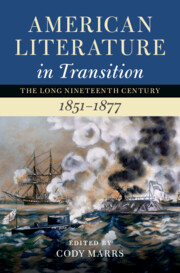Book contents
- American Literature in Transition, 1851–1877
- Nineteenth-Century American Literature in Transition
- American Literature in Transition, 1851–1877
- Copyright page
- Contents
- Figures
- Contributors
- Series Preface
- Introduction
- Part I Careers
- Chapter 1 Emily Dickinson
- Chapter 2 Frederick Douglass
- Chapter 3 Augusta Jane Evans
- Chapter 4 Herman Melville
- Chapter 5 John Rollin Ridge
- Chapter 6 Walt Whitman
- Chapter 7 Anonymous
- Part II Networks
- Part III Exchanges
- Part IV The Long Civil War
- Index
Chapter 3 - Augusta Jane Evans
from Part I - Careers
Published online by Cambridge University Press: 15 June 2022
- American Literature in Transition, 1851–1877
- Nineteenth-Century American Literature in Transition
- American Literature in Transition, 1851–1877
- Copyright page
- Contents
- Figures
- Contributors
- Series Preface
- Introduction
- Part I Careers
- Chapter 1 Emily Dickinson
- Chapter 2 Frederick Douglass
- Chapter 3 Augusta Jane Evans
- Chapter 4 Herman Melville
- Chapter 5 John Rollin Ridge
- Chapter 6 Walt Whitman
- Chapter 7 Anonymous
- Part II Networks
- Part III Exchanges
- Part IV The Long Civil War
- Index
Summary
In The Shape of Hawthorne’s Career (1976), Nina Baym argues that rather than reading Hawthorne’s works in isolation from one another, critics should read them chronologically in “the context they provide for each other” and as reflecting their author’s “literary sensibility” as it changed over time.1 The shapes of the careers of some of the other figures in this section are well known: Herman Melville was a popular author of sea yarns who withdrew from the market after his popularity declined, leaving Billy Budd in manuscript at his death; Emily Dickinson was a manuscript poet whose productivity ebbed and flowed over several decades, while Walt Whitman revised and expanded his Leaves of Grass many times over nearly half a century; and Frederick Douglass had long careers as both a prominent orator and published author.
Keywords
- Type
- Chapter
- Information
- American Literature in Transition, 1851–1877 , pp. 42 - 57Publisher: Cambridge University PressPrint publication year: 2022

